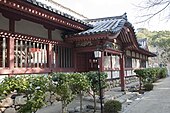Kairō
Kairō (回廊 or 廻廊), bu (廡), sōrō or horō (歩廊) is the Japanese version of a
tō. Nowadays it can be found also at Shinto shrines and at shinden-zukuri aristocratic residences.[1]
The kairō and the Itsukushima Jinja is an example of the mature form of the complex.
Two types of kairō exist, one 1-
bay
wide and another 2-bay wide, the bay being the space between two pillars. The first is by far the most common.
Tanrō
The 1-bay wide type is supported by just two rows of pillars and is therefore called tanrō (単廊, lit. single corridor). Typical windows called renjimado (連子窓) (see gallery) let air and light in.
Fukurō
The 2-bay wide type is supported by three rows of pillars, is called fukurō (複廊, lit. multiple corridors) and is divided in two identical corridors by a wall (see model in the gallery). Although it is known that several existed at major Buddhist temples, for example at Tōdai-ji, none is extant.[4] Some fukurō survive however at Shinto shrines.
Gallery
-
Drawing of a tanrō
-
Drawing of a fukurō
-
Model of a fukurō
-
Plan of Yakushi-ji with the kairō surrounding the garan
-
Iwashimizu Hachiman-gū's fukurō and rōmon
-
External view of a kairō's wall with renjimado
-
View from the entrance of Zentsū-ji's kairō
-
Internal view of Hase-dera's kairō
See also
References
- ^ "Kairou". JAANUS. Retrieved 23 September 2010.
- ^ ISBN 4-8122-9805-9.
- Shinbutsu shūgō.
- ^ "Fukurou". JAANUS. Retrieved 24 September 2010.
Wikimedia Commons has media related to Kairō.











